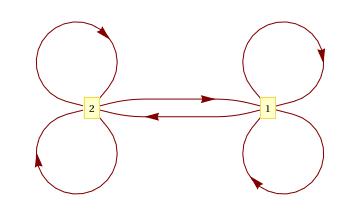On 08/22/2013 04:25 PM, Tamás Nepusz
wrote:
Thank you very much. but does that mean igraph cannot handle multigraph isomorphism?It can, with a trick. You have to collapse multiple edges into a single edge and assign the original edge count to the new edge as an edge attribute. Then you can use the edge_color1 and edge_color2 arguments of isomorphic_vf2 to disallow matching an edge to another with a different multiplicity. E.g.: # Construct the graphs g1 = igraph.Graph([(0,1),(1,0),(0,0),(1,1)], directed=True) g2 = igraph.Graph([(0,1),(1,0),(0,1),(1,0)], directed=True) # Declare that each edge in the graph has a multiplicity of 1 (because we still have multiple edges) g1.es["multiplicity"] = 1 g2.es["multiplicity"] = 1 # Collapse the multiple edges into a single one and sum the multiplicities g1.simplify(multiple=True, loops=False, combine_edges="sum") g2.simplify(multiple=True, loops=False, combine_edges="sum") # Now check whether they are isomorphic, considering the multiplicities print g1.isomorphic_vf2(g2, edge_color1=g1.es["multiplicity"], edge_color2=g2.es["multiplicity"])
Thank you, that really helped a lot!
the simplify() function indeed distinguishes a lot of different graphs. but it seems the edge_color argument does not work as expected. see this example:
----------------------------------------------
g = igraph.Graph( [ (0,1), (1,0), (0,0), (0,0), (0,0), (1,1) ], directed=True )
g1 = igraph.Graph( [ (0,1), (1,0), (0,1), (1,0), (0,0), (1,1) ], directed=True )
g.es['multiplicity'] = 1
g1.es['multiplicity'] = 1
g.simplify(multiple=True, loops=False, combine_edges='sum' )
g1.simplify(multiple=True, loops=False, combine_edges='sum' )
print g.isomorphic_vf2( g1, edge_color1=g.es['multiplicity'], edge_color2=g1.es['multiplicity'] )
-----------------------------------------------
the result is still True, but should be False. Here's the graphs:


--
周达,Day Zhou
Interdisciplinary Center for Theoretical Study (ICTS)
University of Science and Technology of China (USTC)